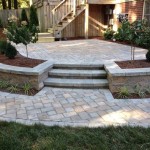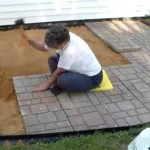How To Install 12x12 Patio Pavers
Installing a patio using 12x12 pavers is a manageable DIY project for homeowners with basic landscaping knowledge and access to the right tools. A properly installed patio not only enhances the aesthetic appeal of a property but also provides a durable and functional outdoor living space. The following guidelines detail the process of installing a patio using 12x12 pavers, ensuring a stable and visually appealing result.
Planning and Preparation
The initial stage involves meticulous planning and preparation, which are crucial for a successful patio installation. This encompasses determining the patio's size and shape, marking the area, and calculating the necessary materials. Neglecting this preliminary stage can lead to material shortages or design flaws that necessitate costly revisions later on.
Begin by accurately measuring the area designated for the patio. Mark the perimeter using stakes and string. Ensure the marked area aligns with any existing structures, such as the house or walkways. Consider the patio's intended use when determining its size. A small patio might suffice for a bistro set, while a larger patio is necessary for outdoor dining or entertaining.
Next, calculate the number of 12x12 pavers required. Calculate the total square footage of the patio area. Since each 12x12 paver covers one square foot, the total square footage directly translates to the number of pavers needed, plus an overage. It is advisable to add an additional 5-10% to the calculated amount to account for cuts, breakage, and potential future repairs. Order the pavers from a reputable supplier, ensuring they are of consistent quality and color.
Beyond the pavers themselves, you will require a sufficient quantity of base materials. These materials typically include gravel for the sub-base and sand for the setting bed. The gravel provides a stable foundation, while the sand creates a level surface for the pavers to rest upon. The amount of gravel and sand needed will depend on the depth of each layer, which is typically 4-6 inches for the gravel sub-base and 1-2 inches for the sand setting bed. Use a cubic yard calculator to determine the volume of gravel and sand needed for the project area. Contact local landscaping suppliers for pricing and delivery options.
Accurate estimations of material quantities are critical to avoid interruptions during the installation process. Insufficient material can delay the project, while excessive material results in unnecessary expenses.
Gather the necessary tools for the job. Essential tools include a shovel, measuring tape, level, tamper, wheelbarrow, work gloves, safety glasses, a rubber mallet, a utility knife or paver splitter (for cutting pavers), and a broom. Availability of the correct tools can enhance efficiency and ensure the desired outcome.
Excavation and Base Preparation
Following the planning stage, the physical work commences with excavation and base preparation. This involves removing the existing soil to create space for the gravel sub-base and sand setting bed. Proper excavation and base preparation are essential for preventing settling and ensuring the longevity of the patio.
Excavate the area within the marked perimeter to a depth that accounts for the thickness of the pavers, the sand setting bed, and the gravel sub-base. As previously mentioned, the gravel sub-base typically requires a depth of 4-6 inches, the sand setting bed 1-2 inches, and the pavers themselves are 1 inch thick. Thus, the total excavation depth should be at least 6-9 inches. Remember to maintain a slight slope (approximately 1/8 inch per foot) away from any structures to facilitate proper drainage. This slope prevents water from pooling on the patio surface.
Compact the exposed soil at the bottom of the excavated area using a hand tamper or plate compactor. This compaction strengthens the soil and provides a stable base for the subsequent layers. Inadequate compaction can lead to settling and uneven paver surfaces over time.
Spread the gravel evenly over the compacted soil, creating the sub-base. Use a rake or shovel to distribute the gravel uniformly. The gravel should consist of crushed stone or road base material that compacts well. After spreading the gravel, compact it thoroughly using a hand tamper or plate compactor. Multiple passes with the compactor may be necessary to achieve optimal compaction. A well-compacted gravel sub-base provides a stable and level foundation for the pavers.
Consider installing landscape fabric between the soil and the gravel sub-base. Landscape fabric prevents weed growth and helps stabilize the sub-base by preventing soil from migrating into the gravel layer. Overlap the edges of the landscape fabric by several inches to ensure complete coverage.
Paver Installation and Finishing
The final stage involves laying the pavers, cutting them as needed, and sweeping polymeric sand into the joints. Accurate paver placement and proper joint filling are critical for achieving a visually appealing and structurally sound patio.
Spread a 1-2 inch layer of sand over the compacted gravel sub-base. Use a rake or shovel to distribute the sand evenly. Screed the sand using a straight board or screed tool to create a perfectly level surface. A level sand setting bed is crucial for ensuring that the pavers sit flush with each other. Minor adjustments can be made by adding or removing sand as needed. It’s important to avoid walking on the leveled sand bed before setting the pavers.
Begin laying the 12x12 pavers, starting from one corner of the patio area. Arrange the pavers in the desired pattern, maintaining consistent spacing between them. A standard gap is between 1/8 and 1/4 inch. Use paver spacers to ensure uniform joint widths. Gently tap each paver into place using a rubber mallet. The rubber mallet prevents damage to the paver surface. Continuously check the level of the pavers as you proceed, making minor adjustments to the sand setting bed as needed. When the pavers reach any edges use the paver splitter to create clean cuts.
If it is necessary to cut pavers to fit around corners or edges, use a paver splitter or a wet saw. A paver splitter provides a clean, straight cut, while a wet saw is useful for more intricate cuts. Always wear safety glasses and gloves when cutting pavers. Ensure that cut pavers fit snugly against adjacent pavers, maintaining a consistent joint width. If using a wet saw, ensure to follow the manufacturer's instructions and safety guidelines for the saw.
Once all the pavers are laid, sweep polymeric sand into the joints between the pavers. Polymeric sand is a specialized type of sand that hardens when activated with water, creating a durable and weed-resistant joint. Follow the manufacturer's instructions for applying the polymeric sand. Typically, this involves sweeping the sand into the joints, compacting it with a broom or hand tamper, and then misting the patio surface with water to activate the polymer. Proper activation of the polymeric sand is crucial for its effectiveness. Avoid overwatering, as this can wash away the sand. Usually multiple light misting sessions are better than one heavy soaking. The hardening process usually takes 24-48 hours depending on humidity and temperature. Avoid foot traffic while the sand sets.
Clean up any excess polymeric sand from the paver surface using a broom or leaf blower. Remove any remaining debris from the patio area. Consider sealing the pavers with a paver sealer to protect them from staining and fading. Paver sealers also enhance the color and appearance of the pavers. Apply the sealer according to the manufacturer's instructions. Paver sealers can be applied with a brush, roller, or sprayer.
Inspecting the final patio for any imperfections such as uneven pavers or poorly filled joints, addressing those issues will ensure the aesthetic quality and structural integrity of the patio. The installation of edge restraints or edging pavers around the perimeter of the patio can help prevent shifting and maintain the patio's shape over time. Edge restraints can be made from plastic, metal, or concrete. They should be installed before the polymeric sand is applied.

Paver Installation Materials Tools And Process Plant Design Group

Patio Pavers Peachtree City Hardscape Patios Fayetteville Ga Landscape Innovations

How To Install A Beautiful Decomposed Granite Patio South House Designs

Cambridge Pavingstones Offer Do It Yourself Pavement System For Your Driveway Pool Deck Patio Or Sunroom Thereporter

Havenbrick Pavers Best Bricks Adelaide Concrete

Premium Blend Pavers Best S Exclusice

Premium Blend Pavers Best S Exclusice

Stradapave Pavers Budget Adelaide Concrete

Flagstone Pavers Best S Adelaide

2024 Paver Patio Cost Installation Costs
Related Posts








